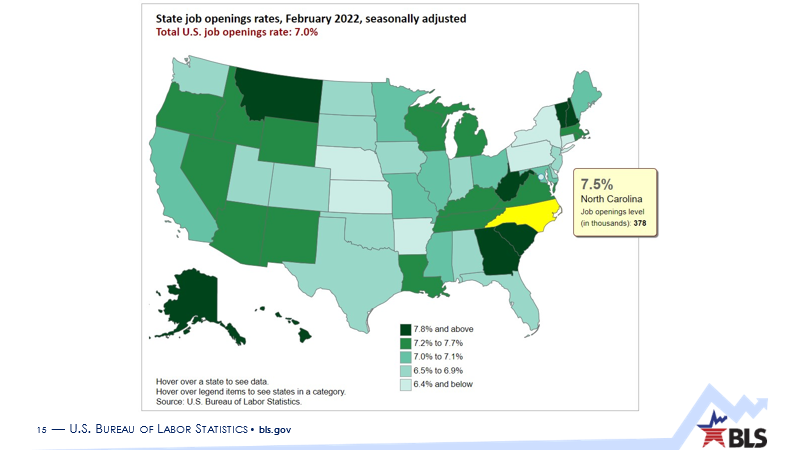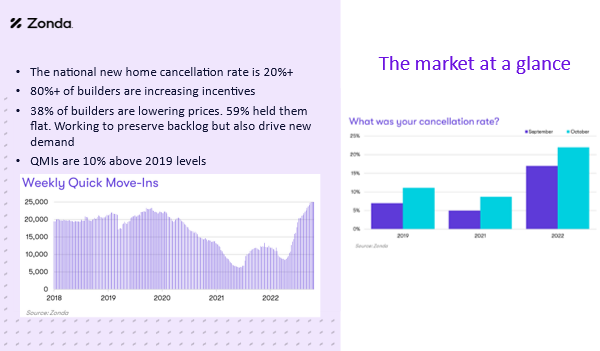Charlotte April 2022 – Key Take Aways
- Timothy Ewing – Bureau of Labor Statistics: Regional Economist for the Bureau of Labor Statistics (BLS) Atlanta office. Timothy begins with data from the Business Response Survey (BRS) and it shows how U.S. business has changed operation systems because of the coronavirus pandemic. The data reveals North Carolina businesses have decreased their office square footage by 6.7% compared to 5.5% nationwide, with another 4.4% noted on the survey that they expect to decrease space in the near future over the next year or so. That’s a total of 11.1%. In contrast to that, 3.6% of North Carolina businesses are looking to increase their square footage. The information sector (IT) leads the major industry sectors with 10.6% of establishments reducing space. The accommodation and food service sector was next, reducing their space by 9.5%, followed by the professional business service sector is at 8.5%. The data further revealed that all major industry sectors are increasing the amount of telework offered to their employees. In North Carolina, about 34.1% of establishments increased telework for employees in 2021, just below the national average at 35%. Unemployment February 2022 estimates for North Carolina is seeing unemployment rate drop at 3.7%, with about two job openings per unemployed worker. This symbolizes a tight labor market and could be an indicator for rising wages in particular job areas. Pre-pandemic, there was relatively small growth with a large decline in Import and Export Price Indexes. During and post-pandemic, the Producer Price Index and the Import and Export Price Indexes each had double digit increases, driven by several external factors including the pandemic, shipping glaze, chip shortage, worker shortages, consumer demand and the Ukraine and Russian crisis.
- Joe Kinsey – CoStar Group: He emphasizes the strength of the retail market in Charlotte. Vacancies are very low and retail brokerage clients are struggling to find space for retailers, whether it be land to build on or redevelop projects. The presentation shows the strongest performance from leasing, and from a sales per-square-foot basis, strip centers, ex. Fort Mill and Rock Hill with a tenant/Amazon-proof mix. Same goes for industrial and multi-family. Joe notes capital is flowing in but smaller companies are finding it hard to find product and compete with the big players. This is causing push-out into Wilmington, Greensboro and Columbia areas.
- Russell Hughes – Hughes Realty: Russell finds it interesting to see how quickly prices are to fall off but also how difficult it is to find land, in reference to his most recent trip to Columbia. He affirms the “easy” sites are all taken.
- Gates Grainger – Investors Title Company: Gates heeds patience with title industry because times are extremely busy. Deal closings are taking longer and are not immediate. A good title could take a week to complete and a full search requires a minimum of 2 weeks. He recommends accurate and realistic due diligence deadlines so that they may be met accordingly. He continues on with boom in activity of new sectors, including hotel and hospitality, in areas beyond Charlotte and North Carolina. He is unsure as to the cause of this.
- Ron Rothfuss – Terracon: Ron highlights the hike in industrial activity on the I-85. He observes opportunities in high-rise residentials, citing Terracon’s projects which include two 40-story levels, one 30-story level and a few others in Uptown. He concludes stating that the Carolina Panther practice stadium is on hold indefinitely.
- Neal McElveen – Terracon: Neal states much activity is seen on the 1-85 from warehouse, industrial, e-commerce, data centers, etc. Due diligence is largely affected due to the rise in people quitting within the field. What used to take 7-15 days is now taking around 21. Immediate, emergency requests are no longer an option, however, possible if last-minute cancellation occurs. Prices associated with this are significantly higher. He urges at least 3-4 weeks on requests, depending on the types of requests and activity on them. He ends with upsurge of state-level brownfields due to lack of available land.
- Tanna Thomas – Terracon: Tanna expresses concern for backup all across the board as well as clients’ unrealistic expectations of this. She suggests managing full-time and sharing when something can and cannot be done (since they’re in a position to do so).
- Gordon Allebach – G Brokerage Commercial Real Estate: Gordon notices a flip in requests within the last 6 months from multi-family and industrial to land. The challenge is finding available land. He comments on the copious flow of capital, with recent deals bidding over asking price. He is unsure of how long this will continue.
- Michael Stolorena – G Brokerage Commercial Real Estate: He touches upon Casey Conway’s I-85 Conference speech, regarding the development of larger, deeper warehouses for more automation, which would alleviate the labor shortage.
- Martha Fakadej – Jones Lang LaSalle Americas, Inc.: What used to take days is now taking the government months to review; permits and drawings, creating extraordinarily longer carrying costs for clients. She suggests strategizing how master development schedules are working so that projects may be slightly longer but more successful overall. She encourages placing valuable time into building solid relationships. She finishes with mention of recent spike in interest of brownfields and geopiers.






Recent Comments